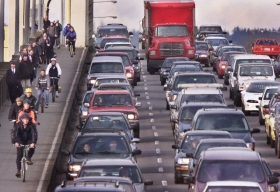Urban Mobility - It's Not Getting Better

In 2007, congestion caused urban Americans to travel 4.2 billion hours more and to purchase an extra 2.8 billion gallons of fuel for a congestion cost of $87.2 billion - an increase of more than 50% over the previous decade.
This was a decrease of 40 million hours and a decrease of 40 million gallons, but an increase of over $100 million from 2006 due to an increase in the cost of fuel and truck delay.
Small traffic volume declines brought on by increases in fuel prices over the last half of 2007 caused a small reduction in congestion from 2006 to 2007.
Delay per traveler - the number of hours of extra travel time that commuters spend during rush hours - was 1.3 hours lower in 2007 than 2005. This change would be more hopeful if it was associated with something other than rising fuel prices (which occurred for a short time in 2005 and 2006 before the sustained increase in 2007 and 2008) and a slowing economy.
This same kind of slow growth/decline over a few years occurred in the early 1990s when spending and growth in the high-tech and defense sectors of the economy declined dramatically.
The decline means congestion is near the levels recorded in 2003, not exactly a year remembered for trouble-free commuting.
The strategies must address the issue that the problems are not the same in every region or on every day - the variation in travel time is often as frustrating and costly as the regular "daily slog" through traffic jams.
The 2009 Urban Mobility Report clearly demonstrates that all the solutions are not being implemented fast enough.
More information on the possible solutions, places they have been implemented, the effects estimated in this report and the methodology used to capture those benefits can be found on the website http://mobility.tamu.edu/.
- Get as much service as possible from what we have - Many
low-cost improvements have broad public support and can be rapidly
deployed. These management programs require innovation, constant
attention and adjustment, but they pay dividends in faster, safer
and more reliable travel. Rapidly removing crashed vehicles, timing
the traffic signals so that more vehicles see green lights,
improving road and intersection designs, or adding a short section
of roadway are relatively simple actions.
- Add capacity in critical corridors - Handling greater freight or
person travel on freeways, streets, rail lines, buses or intermodal
facilities often requires "more." Important corridors or growth
regions can benefit from more road lanes, new streets and highways,
new or expanded public transportation facilities, and larger bus and
rail fleets.
- Change the usage patterns -There are solutions that involve
changes in the way employers and travelers conduct business to a oid
traveling in the traditional "rush hours." Flexible work hours,
internet connections or phones allow employees to choose work
schedules that meet family needs and the needs of their jobs.
- Provide choices - This might involve different routes, travel
modes or lanes that involve a toll for high-speed and reliable
service - a greater number of options that allow travelers and
shippers to customize their travel plans.
- Diversify the development patterns - These typically involve
denser developments with a mix of jobs, shops and homes, so that
more people can walk, bike or take transit to more, and closer,
destinations. Sustaining the "quality of life" and gaining economic
development without the typical increment of mobility decline in
each of these sub-regions appear to be part, but not all, of the
solution.
- Realistic expectations are also part of the solution. Large urban areas will be congested. Some locations near key activity centers in smaller urban areas will also be congested. But congestion does not have to be an all-day event. Identifying solutions and funding sources that meet a variety of community goals is challenging enough without attempting to eliminate congestion in all locations at all times.
The base data for this report are from the Federal Highway Administration's Highway Performance Monitoring System. More information on the methodology is included on the FHA website.
an initiative of the GLOBE Foundation of Canada.
Visit GLOBE-Net for more news and articles and
sign up to GLOBE-Net's free weekly newsletter
|
© 1997-2009 World Business Council for Sustainable Development (WBCSD). All rights reserved. To subscribe or visit go to: http://www.wbcsd.org